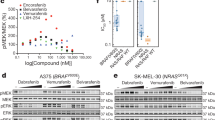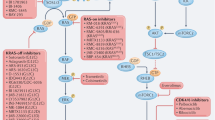Abstract
Activated RAS promotes dimerization of members of the RAF kinase family1,2,3. ATP-competitive RAF inhibitors activate ERK signalling4,5,6,7 by transactivating RAF dimers4. In melanomas with mutant BRAF(V600E), levels of RAS activation are low and these drugs bind to BRAF(V600E) monomers and inhibit their activity. This tumour-specific inhibition of ERK signalling results in a broad therapeutic index and RAF inhibitors have remarkable clinical activity in patients with melanomas that harbour mutant BRAF(V600E)8. However, resistance invariably develops. Here, we identify a new resistance mechanism. We find that a subset of cells resistant to vemurafenib (PLX4032, RG7204) express a 61-kDa variant form of BRAF(V600E), p61BRAF(V600E), which lacks exons 4–8, a region that encompasses the RAS-binding domain. p61BRAF(V600E) shows enhanced dimerization in cells with low levels of RAS activation, as compared to full-length BRAF(V600E). In cells in which p61BRAF(V600E) is expressed endogenously or ectopically, ERK signalling is resistant to the RAF inhibitor. Moreover, a mutation that abolishes the dimerization of p61BRAF(V600E) restores its sensitivity to vemurafenib. Finally, we identified BRAF(V600E) splicing variants lacking the RAS-binding domain in the tumours of six of nineteen patients with acquired resistance to vemurafenib. These data support the model that inhibition of ERK signalling by RAF inhibitors is dependent on levels of RAS–GTP too low to support RAF dimerization and identify a novel mechanism of acquired resistance in patients: expression of splicing isoforms of BRAF(V600E) that dimerize in a RAS-independent manner.
This is a preview of subscription content, access via your institution
Access options
Subscribe to this journal
Receive 51 print issues and online access
$199.00 per year
only $3.90 per issue
Buy this article
- Purchase on Springer Link
- Instant access to full article PDF
Prices may be subject to local taxes which are calculated during checkout



Similar content being viewed by others
Change history
14 December 2011
The author affiliation for T.M. was corrected.
References
Weber, C. K., Slupsky, J. R., Kalmes, H. A. & Rapp, U. R. Active Ras induces heterodimerization of cRaf and BRaf. Cancer Res. 61, 3595–3598 (2001)
Rushworth, L. K., Hindley, A. D., O’Neill, E. & Kolch, W. Regulation and role of Raf-1/B-Raf heterodimerization. Mol. Cell Biol. 26, 2262–2272 (2006)
Wellbrock, C., Karasarides, M. & Marais, R. The RAF proteins take centre stage. Nature Rev. Mol. Cell Biol. 5, 875–885 (2004)
Poulikakos, P. I., Zhang, C., Bollag, G., Shokat, K. M. & Rosen, N. RAF inhibitors transactivate RAF dimers and ERK signalling in cells with wild-type BRAF. Nature 464, 427–430 (2010)
Heidorn, S. J. et al. Kinase-dead BRAF and oncogenic RAS cooperate to drive tumor progression through CRAF. Cell 140, 209–221 (2010)
Hatzivassiliou, G. et al. RAF inhibitors prime wild-type RAF to activate the MAPK pathway and enhance growth. Nature 464, 431–435 (2010)
Joseph, E. W. et al. The RAF inhibitor PLX4032 inhibits ERK signaling and tumor cell proliferation in a V600E BRAF-selective manner. Proc. Natl Acad. Sci. USA 107, 14903–14908 (2010)
Flaherty, K. T. et al. Inhibition of mutated, activated BRAF in metastatic melanoma. N. Engl. J. Med. 363, 809–819 (2010)
Solit, D. B. et al. BRAF mutation predicts sensitivity to MEK inhibition. Nature 439, 358–362 (2006)
Whittaker, S. et al. Gatekeeper mutations mediate resistance to BRAF-targeted therapies. Sci. Transl. Med. 2, 35ra41 (2010)
Cutler, R. E., Jr, Stephens, R. M., Saracino, M. R. & Morrison, D. K. Autoregulation of the Raf-1 serine/threonine kinase. Proc. Natl Acad. Sci. USA 95, 9214–9219 (1998)
Rajakulendran, T., Sahmi, M., Lefrancois, M., Sicheri, F. & Therrien, M. A dimerization-dependent mechanism drives RAF catalytic activation. Nature 461, 542–545 (2009)
Poulikakos, P. I. & Rosen, N. Mutant BRAF melanomas–dependence and resistance. Cancer Cell 19, 11–15 (2011)
McArthur, G. et al. Molecular analyses from a phase I trial of vemurafenib to study mechanism of action (MOA) and resistance in repeated biopsies from BRAF mutation–positive metastatic melanoma patients (pts). J Clin Oncol 29, suppl; abstr 8502. (2011)
Nazarian, R. et al. Melanomas acquire resistance to B-RAF(V600E) inhibition by RTK or N-RAS upregulation. Nature 468, 973–977 (2010)
Johannessen, C. M. et al. COT drives resistance to RAF inhibition through MAP kinase pathway reactivation. Nature 468, 968–972 (2010)
Villanueva, J. et al. Acquired resistance to BRAF inhibitors mediated by a RAF kinase switch in melanoma can be overcome by cotargeting MEK and IGF-1R/PI3K. Cancer Cell 18 683–695 S1535–6108(10)00484–8 (2010)
Wagle, N. et al. Dissecting therapeutic resistance to RAF inhibition in melanoma by tumor genomic profiling. J. Clin. Oncol. 29, 3085–3096 (2011)
Luco, R. F., Allo, M., Schor, I. E., Kornblihtt, A. R. & Misteli, T. Epigenetics in alternative pre-mRNA splicing. Cell 144, 16–26 (2011)
Bollag, G. et al. Clinical efficacy of a RAF inhibitor needs broad target blockade in BRAF-mutant melanoma. Nature 467, 596–599 (2010)
Janakiraman, M. et al. Genomic and biological characterization of exon 4 KRAS mutations in human cancer. Cancer Res 70, 5901–5911 (2010)
Nüsse, M., Beisker, W., Hoffmann, C. & Tarnok, A. Flow cytometric analysis of G1- and G2/M-phase subpopulations in mammalian cell nuclei using side scatter and DNA content measurements. Cytometry 11, 813–821 (1990)
Acknowledgements
We are grateful to M. Baccarini and C. Pritchard for the RAF knockout mouse embryonic fibroblasts. We would like to thank K. Shokat, C. Zhang, S. Chandarlapaty, C. Pratilas and K. Robzyk for useful discussions, C. Liu for her technical expertise and T. J. Riley. We also thank D. Hucks for technical assistance, P. L. Lyle for scoring the tumour sections, and T. Chodon for assistance with tumour procurement. The ITR is supported by the Vanderbilt-Ingram Cancer Center and the T. J. Martell Foundation. This work has been funded by the National Institutes of Health (NIH; R.S.L., N.R., D.B.S.), the Beene Foundation (D.B.S.), the Melanoma Research Alliance (K.T.F., J.A.S. P.B.C., R.S.L., N.R., D.B.S.) and the STARR Foundation (N.R., D.B.S.). R.S.L. was supported by the Burroughs Wellcome Fund, American Skin Association, Joint Center for Translational Medicine, Sidney Kimmel Foundation, and Stand Up to Cancer. T.M. was supported in part by the Intramural Research Program of the NIH, NCI, Center for Cancer Research and P.B.C. was supported in part by the Danny Federici Melanoma Fund. P.I.P. was supported by T32 CACA062948-15.
Author information
Authors and Affiliations
Contributions
P.I.P., M.J., T.G.G., A.R., R.S.L., N.R. and D.B.S. designed experiments and analysed data. P.I.P., Y.P., M.J., X.K., C.N., G.M., H.S., M.A., B.T., M.T.G., M.S., K.B.D. and M.T. performed experiments and analysed data. J.A.W., K.T.F., M.C.K., J.A.S., P.B.C. and R.S.L. provided tumours for analysis. All authors contributed to the writing of the paper.
Corresponding author
Ethics declarations
Competing interests
J.A.S., P.B.C., N.R. and D.B.S. have participated on an advisory board for Roche. J.A.S. and P.B.C. have received clinical trial research funding from Roche. P.B.C. has received research support and served on an advisory board for Genentech. A.R. has received honorarium serving on the advisory boards of Roche-Genentech. N.R. and D.B.S. have received research funding from Astra-Zeneca.
Supplementary information
Supplementary Information
This file contains Supplementary Figures 1-13 with legends and Supplementary Tables 1-2. (PDF 1596 kb)
Rights and permissions
About this article
Cite this article
Poulikakos, P., Persaud, Y., Janakiraman, M. et al. RAF inhibitor resistance is mediated by dimerization of aberrantly spliced BRAF(V600E). Nature 480, 387–390 (2011). https://doi.org/10.1038/nature10662
Received:
Accepted:
Published:
Issue Date:
DOI: https://doi.org/10.1038/nature10662
This article is cited by
-
BRAF — a tumour-agnostic drug target with lineage-specific dependencies
Nature Reviews Clinical Oncology (2024)
-
Detecting and understanding meaningful cancerous mutations based on computational models of mRNA splicing
npj Systems Biology and Applications (2024)
-
Live-cell target engagement of allosteric MEKi on MEK–RAF/KSR–14-3-3 complexes
Nature Chemical Biology (2024)
-
SOX10 deficiency-mediated LAMB3 upregulation determines the invasiveness of MAPKi-resistant melanoma
Oncogene (2024)
-
Targeting CRAF kinase in anti-cancer therapy: progress and opportunities
Molecular Cancer (2023)
Comments
By submitting a comment you agree to abide by our Terms and Community Guidelines. If you find something abusive or that does not comply with our terms or guidelines please flag it as inappropriate.



